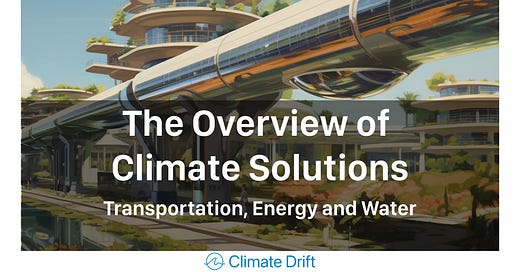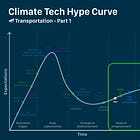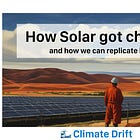Join Climate Drift: your handbook to unraveling climate solutions and realizing your essential part in the journey to net zero.
Not on board yet? Sign up here:
Hey there! 👋
Skander here.
Welcome to the last Part, Part 4, of our series where we dive into solution maps across 12 areas, ranging from Transportation to Energy and Water.
Today it is time for… Transportation, Energy and Water.
As always for each map, I've provided a concise overview, targeting around 200 words for brevity.
Let’s dive in 🌊
Transportation
Over the past thirty years, economic growth and increased car reliance have driven up emissions from transport. Though we are making progress on some fronts there is a long way to go by rail (get it?).
Check out our exploration along the Hype Curve of the Transportation Solutions:
First, while cities are trending towards sustainable transport modes like rapid transit and bicycles, this shift must accelerate to align with climate targets. Access to low-carbon travel options, like improved bike lanes and efficient public transit, is vital.
Second, the popularity of private cars needs fall. Travel by passenger cars grew from 39% in 2015 to 44% in 2020.
Thirdly, the rise of zero-emission vehicles presents a beacon of progress. Electric vehicles (EVs) accounted for nearly 9% of light-duty sales in 2021, doubling from 2020. With the right policies, EVs are increasingly rivaling traditional vehicles in cost. Zero-carbon heavy-duty vehicles, though a small portion of 2022's sales, saw a notable increase, and zero-emission bus sales skyrocketed, largely fueled by China's market.
Lastly, the maritime and aviation sectors require a zero-carbon transformation. Sustainable aviation fuels are slowly gaining traction, as seen by recent substantial purchase agreements. Meanwhile, innovations like green hydrogen and e-methanol in maritime shipping hint at a zero-emission future.
Power
The global power sector is evolving rapidly. Since 2010, renewables have become increasingly cost-effective, challenging traditional fossil fuels like coal.
For an intro on this, check out How Solar got Cheap:
By 2019, zero-carbon sources, such as renewables and nuclear, provided 36.4% of global energy, a rise from 32.3% in 2010. Despite these advancements, coal's dominance persists in areas like China, and post-COVID, there's been a surge in fossil gas-based power. Notably, 2021 saw record power system emissions.
Russia's actions in Ukraine have rekindled Europe's reliance on fossil fuels due to gas shortages, causing nations like Austria and Germany to momentarily turn back to coal.
We need to build out and improve Renewables, while also improving our Grid, making it smart, keeping up with maintenance and building out new transmission lines. Storage is another solutions field that saw a lot of progress and will need even more. Last but not least: how can we make sure that our current fossil fuel extraction and infrastructure is the least impactful it has ever been, while we face it out.
Water
Climate change poses significant challenges to the global water supply, affecting precipitation patterns, glacial melt rates, and evaporation, which in turn impact both the quantity and quality of available freshwater. As populations grow and water becomes scarcer, it is important to implement innovative solutions to manage this critical resource effectively.
Conservation is key. Monitoring and Efficiency tools, such as smart meters and advanced sensor networks, offer real-time data on water use, enabling municipalities and individuals to make informed consumption choices. Wastewater recycling transforms used water into a viable supply source, reducing the demand on fresh resources. Irrigation techniques, like drip irrigation, target water delivery to where it's most needed, reducing wastage in agricultural settings. Lastly, Purification systems, such as biofiltration and reverse osmosis, ensure that water is safe for consumption, irrespective of its source.
Beyond conservation, Extraction methods can tap previously underutilized sources. Desalination turns seawater into drinkable water, albeit with energy and environmental concerns. Rainwater harvesting systems capture and store precipitation for domestic and agricultural use, reducing strain on groundwater. Atmospheric water extraction devices, still in their infancy, promise to draw moisture directly from the air.
In the face of climate change, a strategy that combines conservation and extraction ensures a sustainable water future.
Thank you for journeying with us through our initial exploration of solutions at Climate Drift. This overview merely skims the surface of the solutions we plan to share and dive deeper on.
We are looking forward to your feedback and are open to any areas you feel we might have overlooked.
Skander
PS: If you liked it, share it:










